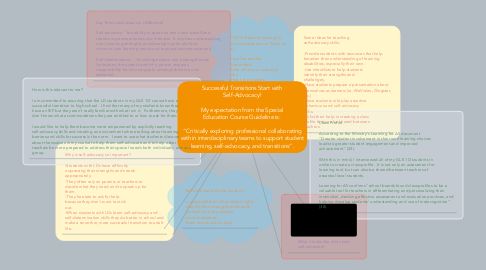Successful Transitions Start with Self-Advocacy! My expectation from the Special Education Course Guideline is: “Critically exploring professional collaborating within interdisciplinary teams to support student learning, self-advocacy, and transitions”.
von Kelly Blackstock

1. Key Terms and ideas via LD@school Self-advocacy: "the ability to speak on one's own behalf and represent personal needs and interests. It involves understanding one's learning strengths and developing the ability to communicate learning needs and required accommodations". Self-determination: "knowledge about one's strengths and limitations; the extent to which a person assumes responsibility for his own goals, accomplishments, and setbacks".
2. Why is self-advocacy so important? -Students with LDs have difficulty expressing their strengths and needs appropriately. -They often rely on parents or teachers to decide what they need and to speak up for them. -They hesitate to ask for help because they don't want to stick out. -When students with LDs learn self-advocacy and self-determination skills they do better in school and make a smoother, more successful transition to adult life.
3. How is this relevant to me? I am committed to ensuring that the LD students in my GLE 1O course have a successful transition to high school. I find that many of my students know they have an IEP but they aren't really familiar with what is in it. Furthermore, they don't know what accommodations they are entitled to or how to ask for them. I would like to help them become more empowered by explicitly teaching self-advocacy skills and creating an environment where talking about learning barriers and skills for success is the norm. I want to use what students discover about themselves in my course to help them self-advocate and to help other teachers be more prepared to address their special needs both individually and as a group.
4. Teachers need to help students: -understand their LD and their rights -identify their strengths and needs -be familiar with available accommodations -learn how to ask for help
5. FESTA--Steps for asking for accommodations via Prater et al.: Face the teacher Eye contact State what you need and why Thank the teacher Accommodation (use it)
6. Some ideas for teaching self-advocacy skills: -Provide students with resources that help broaden their understanding of learning disabilities, especially their own. -Use checklists to help students identify their strengths and challenges, -Have students prepare a presentation about themselves as learners (ie. WeVideo, Glogster, etc.) -Have students role play assertive behaviours and self-advocacy skills. -Enlist their help in creating a class profile that can be shared between teachers.
7. What it looks like when kids self-advocate!
8. Class Profile According to the Ministry's Learning for All document "Greater student involvement in their own learning choices leads to greater student engagement and improved achievement" (33). With this in mind, I interviewed all of my GLE 1O students in order to create a class profile. It is not only an assessment for learning tool, but can also be shared between teachers of essential level students. Learning for All confirms "school boards found class profiles to be a valuable tool for teachers in differentiating and personalizing their instruction, devising effective assessment and evaluation practices, and helping develop students' understanding and use of metacognition" (38).


